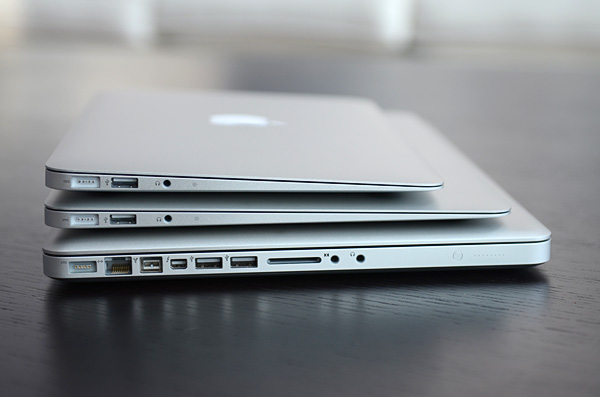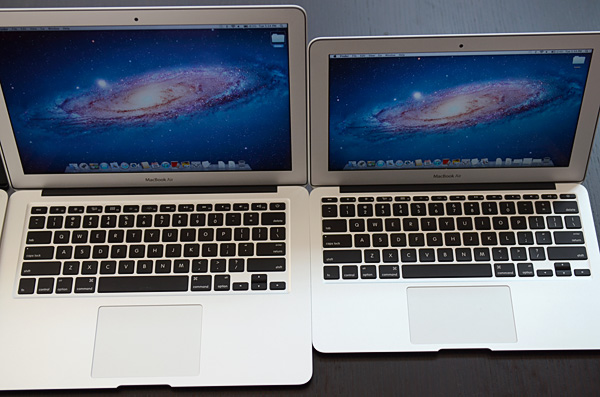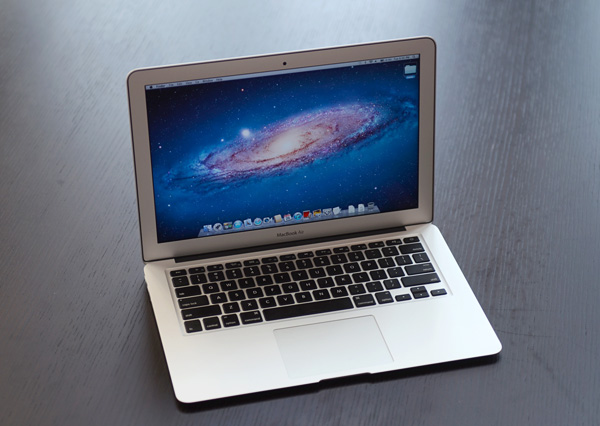The 2011 MacBook Air (11 & 13-inch): Thoroughly Reviewed
by Anand Lal Shimpi on July 28, 2011 3:25 AM EST- Posted in
- Apple
- Mac
- Intel
- Sandy Bridge
- MacBook Air
- Laptops
The 11
The 11-inch MacBook Air comes with a 1366 x 768 display (16:9) measuring 11.6-inches along the diagonal. Ports and features are near identical to last year's model. Up top there's a 640 x 480 camera. Along each side is a USB 2.0 port. Mag Safe and headphone jack are on the left, while Thunderbolt is on the right. There's a single fan inside the chassis that vents between the keyboard and the display hinge.
The 11 is still an amazing form factor. It's painless to carry around and you end up with a tablet sized device that makes no functional sacrifices. To make things even better, now you get a full blown Sandy Bridge CPU inside the ultra slim chassis.
There are really only two things that the 11-inch MacBook Air lacks. For starters, the lack of an integrated SD card reader means anyone looking to do photo work on the go will either need an Eye-Fi or an external USB card reader. Neither is too much of a pain however an integrated reader would be much appreciated.
The second issue with the 11 is its screen size/resolution. At 1366 x 768 you get great pixel pitch on the 11-inch 16:9 screen but there's just not a lot of vertical resolution on the display. The 13-inch model gives you only 5% more horizontal resolution but 17% more vertical, and that's noticeable.
Lion does alleviate some of this problem thanks to its full screen mode. Viewing Mail or Safari in full screen is almost necessary on the 11. Thanks to the 16:9 ratio of the panel, watching movies on the 11 is nearly equivalent to watching them on the 13-inch Air.
The base $999 configuration only comes with 2GB of DDR3 and a 64GB SSD. The latter is excusable if you just don't do much with your system (and technically it's something you can upgrade down the line if you'd like) but the former is a major problem. Memory on the MacBook Air is soldered directly onto the motherboard. Not having to build in a socket helps keep the z-height of the system down to a minimum, but it also severely limits flexibility. For most users interested in a dual-core machine under OS X I'd say that 4GB is probably good enough. While I'd prefer the option of upgrading to 8GB, I think 4GB is livable; 2GB is not. If you're considering the entry-level 11-inch MacBook Air I'd strongly recommend at least upgrading the memory to 4GB. The only exception is if you're just going to spend your time doing very basic tasks on the machine and plan on upgrading again in a year or two. If that's the case save your money and enjoy a 4GB version with Ivy Bridge next year. For everyone else, make sure you get the memory upgrade.
The 13
While the 11 is almost tablet-like, the 13-inch MacBook Air still looks and feels like a normal notebook. A really thin, really light notebook. You get a 1440 x 900 (16:10) display that measures 13.3-inches along the diagonal. The port layout is identical to the 11 although you get an integrated SD card reader along the right of the machine.

From top to bottom: 11-inch MacBook Air, 13-inch MacBook Air, 15-inch MacBook Pro
The 13 is really a pleasure to use, despite feeling a lot like a traditional notebook. The biggest difference for me between it and the 11 is the height of the display. Seated on a couch with the notebook in my lap the 13 doesn't force me to look down as much to see the screen. I still have to tilt my head down a bit, just not as much as with the 11.
The 13-inch screen maintains a relatively high pixel density, just shy of the 128 pixels per inch you get from the 15-inch MacBook Pro with the upgraded 1680 x 1050 display. I find the 13 is a bit easier to look at than the 11 with its 135 PPI display, but that's a personal preference. Apple really needs to increase the resolution of its 13-inch MacBook Pro which is a paltry 1280 x 800.

13-inch MacBook Air (left) vs. 11-inch MacBook Air (right)
The 13's base configuration is actually really good. You get 4GB of memory (neither Air supports more than 4GB of RAM) and a 1.7GHz Core i5. The 1.7GHz part here is a bit more interesting than the 1.6GHz chip in the 11 because it supports much higher max turbo frequencies (2.4/2.7GHz vs. 2.0/2.4GHz). If you don't need more than 128GB of internal storage, my recommendation would be to go for the base 13 at $1299.











103 Comments
View All Comments
dertechie - Thursday, July 28, 2011 - link
Actually, I can see a $500 19x12 14" Thunderbolt Panel doing pretty well for them. It certainly won't move numbers but it is a more practically priced Thunderbolt display. I'd buy one, but admittedly I already want a 24" IPS panel with DisplayPort for an Eyefinity setup, using it as a docking station for my laptop is gravy.To be bluntly honest, if Intel wants to see Thunderbolt take off, the Thunderbolt-fed multipurpose displays are where it will happen, and it needs to encourage that. Storage won't sell it outside the Mac niche, USB3's backwards compatibility with * will destroy it there. But a display with the connectivity that desktops take for granted is an easier sell (and likely easier to tunnel that it would be over USB3). I can see other OEMs selling 22" 1080p ones with good connectivity at ~$250-300 (the TB chip itself is something like $40)
I think given a few years we'll have seen manufacturers test out displays and docking stations with everything from backup HDDs (complements an SSD laptop well) to external GPUs integrated into them. With a low enough latency connection, you can do all sorts of cool things.
darwinosx - Saturday, July 30, 2011 - link
You could show them a TN panel next to an IPS display. The differences are obvious.Wally Simmonds - Thursday, July 28, 2011 - link
If I were looking at buying a netbook today, I'd probably go out right now and grab this, however I already have a HP DM1Z. Okay, CPU performance isn't nearly as good, its body isn't as good looking or solid, and doesn't have a SSD, but looking at the battery life and graphics performance the E-350 based netbooks seem to fare better.It'd be nice to see some other pc manufacturers do something similar in looks/specs to the air but get some halfway decent graphics performance in there - Llano anyone?
Might see some price drops on the Samsung Series 9 too, here in NZ they're selling for *more* than the new MBA's....
quiksilvr - Thursday, July 28, 2011 - link
Just get an SSD for your DM1Z now and save the money wasted- er I mean spent on this.http://www.newegg.com/Product/Product.aspx?Item=N8...
There really is no real need for crazy pixel pushing CPU performance in this day and age for an ultraportable since almost everything is hardware accelerated (GPU pushing). Having said that, the E-350 you have runs faster than the fastest DESKTOP Atom processor.
Plus you can also upgrade to 8GB of RAM too for pretty cheap, giving your laptop a real great edge:
http://www.newegg.com/Product/Product.aspx?Item=N8...
Broheim - Monday, August 8, 2011 - link
I'm curious, why would a CPU push pixels... seeing as that's the job of the (i)GPU.darwinosx - Saturday, July 30, 2011 - link
If you read the review you would know this is not a Netbook.Netbooks are cheap miniature laptops with poor quality screens, slow, clunky, and poorly made.
Rasterman - Wednesday, August 3, 2011 - link
DM1Z? lol you must be joking, you are comparing apples to xylophones.damianrobertjones - Thursday, July 28, 2011 - link
It's a shame that the Elitebook review didn't get this much attention and time spent on the review :(Either way I appreciate the information
damianrobertjones - Thursday, July 28, 2011 - link
P.s. How has the thermal paste been applied on these models as there have been reports stating that it's literally slapped all over the place which will lead to issues down the linedarwinosx - Saturday, July 30, 2011 - link
Those '"reports" are BS and they were't about this model anyway.